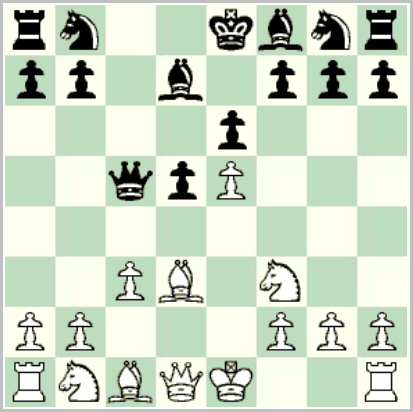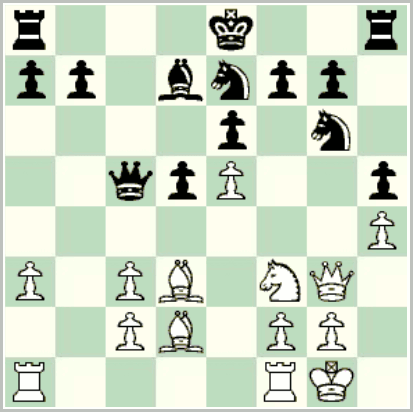Blunders: the bane of every chessplayer. There is almost nothing that can cure the sting, except perhaps for Time, the Great Healer, to work its soothing magic.
Sometimes a small amount of solace can be derived from seeing the same mistake made by a better player, sometimes even–in the ideal case–by a reigning World Champion.
In the 2000 Irish championship in Castleconnell, Co. Limerick, the tournament had hardly begun when disaster befell Eamon Keogh:
 Gavin Wall — Eamon Keogh
Gavin Wall — Eamon Keogh
Irish Championship (1), Castleconnell 2000
1. e4 e6 2. d4 d5 3. e5 c5 4. c3 Qa5 5. dxc5 Qxc5 6. Nf3 Bd7 7. Bd3 (diagram)
And now the blunder: 7. … Bb5?? 8. Be3!
1-0.
After 8. … Qc6 9. Nd4 Black loses a piece. There’s not much to say about that, except to point out the following:
 Vladimir Liberzon – Tigran Petrosian
Vladimir Liberzon – Tigran Petrosian
Championship of the Professional Unions, Moscow 1964
1. e4 e6 2. d4 d5 3. Nc3 Bb4 4. e5 c5 5. a3 Bxc3+ 6. bxc3 Ne7 7. Qg4 Ng6 8. h4 h5 9. Qg3 Qa5 10. Bd2 Nc6 11. Bd3 Nce7 12. dxc5 Qxc5 13. Nf3 Bd7 14. 0-0 (diagram)
14. … Bb5?? 15.Be3 1-0.
There’s a slight puzzle here. With … d4 followed by … Qd5, Black doesn’t have to lose a piece in either case. Instead he’d be a pawn down with a bad position to boot, and would still be lost. Did Petrosian see this possibility? Sources differ: John Moles, in his The French Defence Main Line Winawer (Batsford 1975), p. 104, says no: “1-0?? … Petrosian thought that he would lose a piece after 15…. Qc6?? 16. Nd4 overlooking that he could have got away with the loss of a pawn after 15. … d4! 16. c/B xd4 Qd5!” On the other hand, Tim Krabbé, in his column “A Guided Tour of Chess” at ChessCafe.com, September 2000, says, or rather implies, yes: “Black resigned. Against a lesser opponent, that would have been early. After 15. … d4 16. cxd4 White ‘has the pawn and the compensation’, as Roman Dzindzichashvili used to say, but Black could struggle. Surprisingly he could even have struggled after 15…. Qc6; 16. Nd4 Bxd3 17. Nxc6 Nf5 18. Qg5 Bxf1 19. Nd4 Nxd4 20. cxd4 Ba6 and White still has some work to do. Understandably, Petrosian did not fancy being subjected to that kind of work, and was probably too disgusted anyway.” Taylor Kingston says no, in a bulletin board post at ChessKB.com (14th August 2010): “Petrosian thought he was losing a piece here (15. … Qc6? 16. Nd4), but in fact he need lose only a pawn (15. … d4!).”
Is there any evidence on whether Petrosian did or did not see this? And did Eamon Keogh see it?
